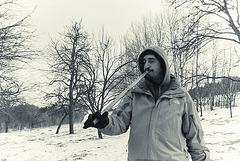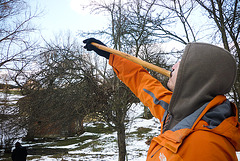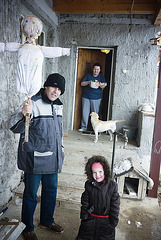
People 人
Goodbye Beijing! 再见,北京!
| |
|
|
|
Jarná víla v zimnom šate / Spring fairy in winter…
| |
|
Na rúbani / Cut woods
| |
|
Playing / Koncovka
| |
|
|
|
Overtone flutes can be found in many countries throughout the globe, although in many cultures this flute is no longer produced and played. The only other known folk overtone flute is Norwegian seljefloyte or the willow flute. On the other hand in Slovakia, koncovka is widely popular and crafted already for centuries. Thus, it is true to say that in Slovakia you can find the best quality overtone fipple flutes (Koncovkas) available. On contrary, the unique Fujara shepherd bass flute can be found nowhere else but in Slovakia.
Spring tunes / Jarná
| |
|
|
Jednoduchá bezdierová píšťala zvaná "koncovka" si v ostatných rokoch získala medzi ľuďmi takú obľubu, snáď väčšiu ako za dávnych čias, keď sa ešte ozývala na holiach. Možno preto, že jej osobitá stupnica a tóny sú blízke našim srdciam a oheň pri rozfuku koncovky v nás oživuje niečo starodávne a srdcu otvrajúce. Medzi novými hráčmi na staré slovenské píšťaly sa stali ľudia, ktorí hľadajú prostredníctvom hudby uvoľnenie či rozjímanie, ako i milovníci tradičnej ľudovej kultúry, čo dokonca aj profesionálni hudobníci rôznych žánrov.
Simple shepherd fife without finger-holes called "koncovka" is recently gaining popularity among people, perhaps higher than in ancient times, when it still echoed on the mountain pastures. It may be that the scale and distinctive sound is close to our hearts and opening warble bringsing something ancient and joyful. Among the new players on the ancient Slovak whistles have become people who seek release and meditation through music, as well as lovers of traditional folk culture, and even professional musicians of various genres.
Éj!
| |
|
Koncovka is a Slovak duct-blown overtone fipple flute without finger holes, traditionally played by shepherds. The koncovka flute is played by closing and opening the bottom hole of the flute. By increasing the air speed, two different harmonic series of notes can be played with the end either open or closed. Traditional koncovka melodies use the partial Lydian scale available on this instrument.
en.wikipedia.org/wiki/Koncovka
Finfajfilo (slovake: koncovka) estas slovaka popola ligna suprotona fajfilo. Rilate al sia longo havas finfajfilo relative mallarĝan enan truon. Dank' al tio ĝi facile superblovas al pli supraj suprotonoj. En finfajfilo muziko estas kutime uzata lidia modalo. Finfajfiloj estas laŭ la dezirata gamo elfarataj en diversaj longoj. Kutima materialo por elfari ĝin estas ligno de Nigra sambuko.
eo.wikipedia.org/wiki/Finfajfilo
Koncovka je píšťala bez tónových otvorov. Radí sa medzi drevené dychové nástroja, aj keď principiálne môže byť vyrobená aj z iných materiálov. Pomerne často sa v domácich podmienkach vyrába napríklad z PVC. Vzhľadom ku svojej dĺžke má pomerne úzke vŕtanie a vďaka tomu ľahko prefukuje na vyššie alikvótne tóny. S otvoreným koncom je možné prefukovaním zahrať všetky alikvótne tóny až zhruba do siedmeho. Uzavretím konca sa základný tón posunie o oktávu nižšie (kvôli úzkemu vŕtaniu sa však nedá zahrať), prefukovaním sa potom dajú zahrať len nepárne alikvótne tóny. Kombináciou prefukovania a zatváranie koncového otvoru sa tak dá zahrať celá lydická stupnica. Koncovky sa podľa požadovaného ladenia sa vyrábajú rôzne dlhé. Obvyklým materiálom na ich výrobu je drevo bazy čiernej.
sk.wikipedia.org/wiki/Koncovka_(p%C3%AD%C5%A1%C5%A5ala)
Morena / Marzanna tradition, 2013, Myjava
| |
|
|
Morena je staroslovanská bohyňa zimy a smrti, veľmi známa i v dnešnom folklóre. Je zosobnená zimou, na jar končí jej vláda. Tradičným rituálom je vynášanie Moreny a jej upálenie alebo utopenie. Najčastejšie sa hádže z mosta alebo zo skaly. Je veľmi zaujímavé, že napriek tisícročnému potláčaniu pohanských rituálov sa dodnes zachoval jeden z nich vo veľmi živom zvyku vynášania Moreny. Vynášanie Moreny malo zabezpečiť definitívny odchod zimy a vítanie jari, vypudenie negatívnych síl z chotára, vrátiť požehnanosť vegetácie, fyzickú silu zeme, dosiahnuť znovuoživenie prírody.
Morena (Marmuriena, Marzhana) is the Old Slavic goddess of winter and death, but it is still well known in today's folklore. She personifies the harsh winter season, and in spring her reign ends. The traditional ritual is that (initially only young girls) carry Morena out of the village and burn or drown her (or both). It is most often thrown from a bridge or a rock. It is very interesting that despite hundreds of years of suppression of pagan rituals, one of them has survived to this day in the very lively custom - the carrying out the Morena. The ritual was to ensure the final departure of winter and the welcoming of spring, the expulsion of negative forces from the society, the return of the bliss of vegetation, the physical strength of the earth, and the rebirth of the nature.
Marina & Morena
| |
|
|
Tak, ako si ctíme Slnko a Matku Zem, tak si ctíme aj chody a javy, ktoré svojimi cestami ukazujú. Ak zo slnečnej – Svarogovej žiary bol podľa staroslovanskej báje uhnietený tento svet, a ak naše žitia a vývoje súvisia taktiež so Zemou, tak striedanie ročných období naskutku až posvätným chodom po veky sa javilo. I keď na to v dvadsiatom storočí mnohí pozabudli, dnes, po vzhliadnutí vedeckých i dejotvorných drsných filmových videní aj menej uvedomelí ľudia začínajú chápať, aká dôležitá je prírodná rovnováha a jej počasné pravidlá. Vítanie jari naisto je jednou z najdôležitejších udalostí roku.
Just as we honour the Sun and the Mother Earth, so do we honour the happening and phenomena that they show on their paths. If this world was knitted out of the sunshine - Svarog's glow according to the ancient Slavic myth - and if our lives are also related to the Earth. Then the changing of the year's seasons has appeared to be almost a sacred course for ages. Although many forgot this in the 20th century, today, after seeing both scientific and history-making gritty cinematic visions, even less conscious people are beginning to understand the importance of nature's balance and its temporal rules. Welcoming the Spring is surely one of the most important events of the year.
-- Žiarislav
Jarný sprievod / Marzanna tradition
| |
|
|
|
Vynášanie Moreny je starý pohanský zvyk, ktorý symbolicky pretrváva dodnes. Morena bola staroslovanská bohyňa zimy a smrti - zosobnenie niečoho nepríjemného, čoho sa chceli ľudia na jar zbaviť. Rituálnou rozlúčkou s Morenou privolávali teplú a životodarnú jar. Táto tradícia sa zachovala v jemne obmenených podobách v rôznych kútoch Slovenska, ale i v okolitých krajinách.
Carrying out an efigy of Morena is an old pagan custom that continues till today, in symbolic form. Morena is a Slavic goddess of winter and death - the personification of something unpleasant, which people wanted to get rid in the beginning of Spring. By a ritual farewell to Morena our ancestors had asked for warm and life-giving spring. This tradition has been preserved in slightly varied forms in different parts of Slovakia, as well as in neighbouring countries.
Rodinka / A family
| |
|
|
|
Street life of Sandakan
| |
|
Street life of Sandakan
| |
|
|
|
Street life
| |
|
|
|
Street Scenes
| |
|
|
Street scenes IV.
| |
|
|
|
Street scenes II.
| |
|
|
|
Jump to top
RSS feed- Latest items - Subscribe to the latest items added to this album
- ipernity © 2007-2024
- Help & Contact
|
Club news
|
About ipernity
|
History |
ipernity Club & Prices |
Guide of good conduct
Donate | Group guidelines | Privacy policy | Terms of use | Statutes | In memoria -
Facebook
Twitter
















